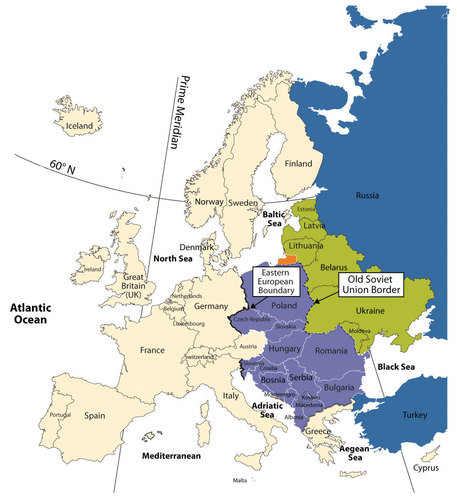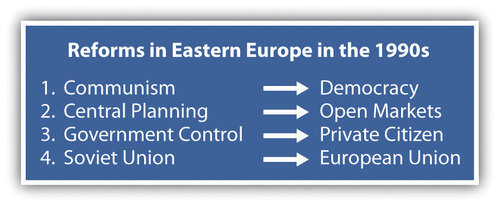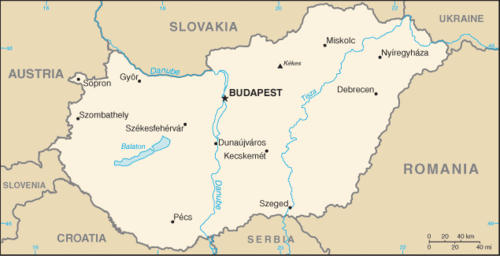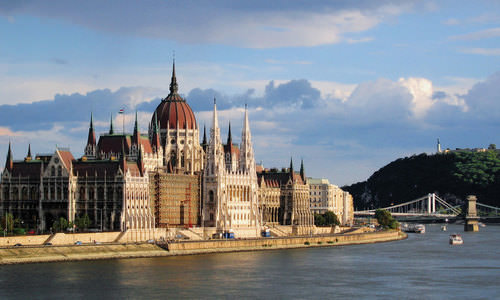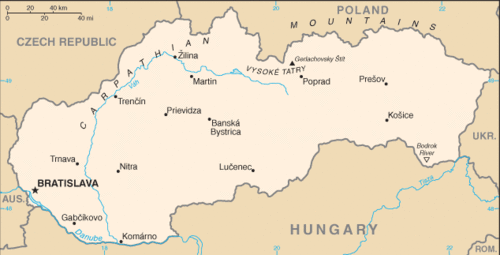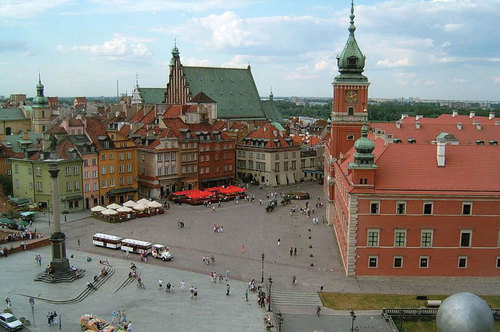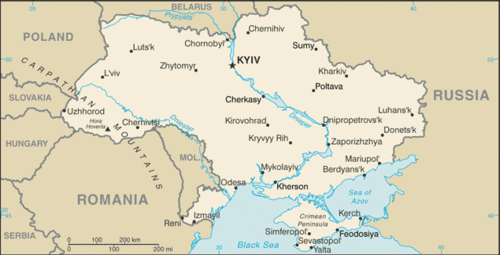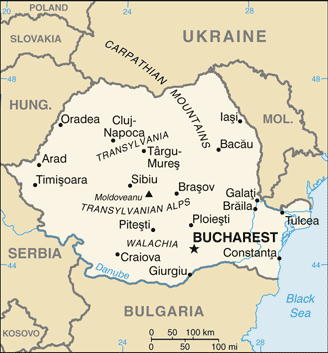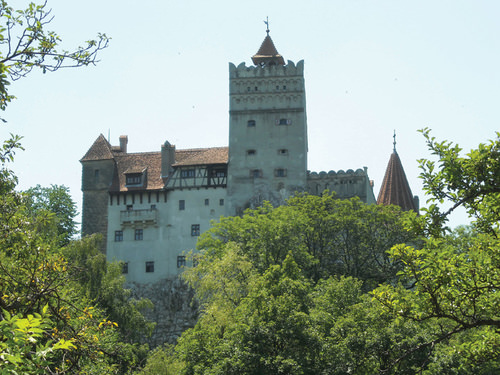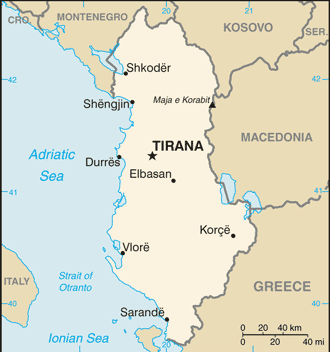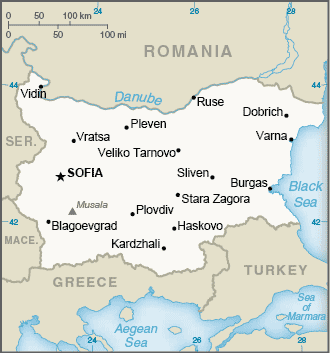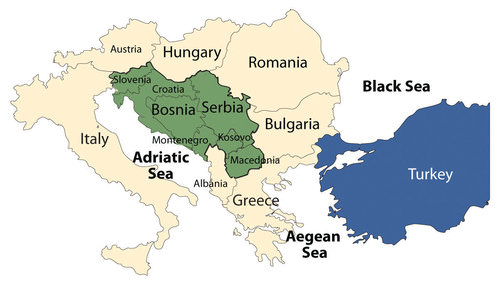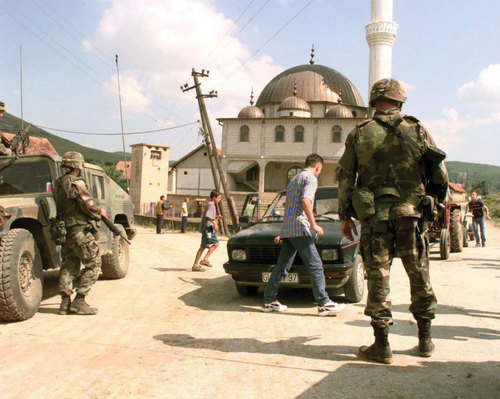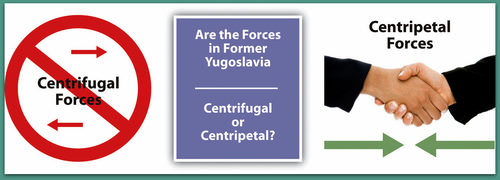东欧(2天)
章节大纲
-
Chapter Challenges
::章次 挑战-
Explain how Eastern Europe and Western Europe were divided and how they united again.
::解释东欧和西欧是如何分裂的,以及它们是如何再次团结起来的。 -
Describe the various aspects of the transition from socialism systems to capitalist democracies.
::描述从社会主义制度向资本主义民主政体过渡的各个方面。 -
Outline which countries were former republics of the Soviet Union but are now a part of Eastern Europe. Define the current borders of Eastern European countries.
::哪些国家是前苏联共和国,但现在是东欧的一部分。 界定东欧国家目前的边界。 -
Describe some of the cultural dynamics that make each region or country unique.
::描述使每个区域或国家具有独特性的一些文化动态。 -
Summarize the basic economic activities that are evident in the various countries and how they have transitioned into a postindustrial economy.
::概述各国明显的基本经济活动以及它们如何过渡到后工业经济的情况。 -
Understand the cultural and political geography of former Yugoslavia and how the drive for nationalism and nation-state status has fractured and divided the region.
::了解前南斯拉夫的文化和政治地理,了解争取民族主义和民族国家地位的动力如何分裂和分裂了该地区。
Student Learning Objectives
::学生学习目标TEKS Regional World Geography Unit 05 Europe: Chapter 5.5 Eastern Europe
::欧洲:第5.5章 东欧WG.2A Describe the human and physical characteristics of the same regions at different periods of time to evaluate relationships between past events and current conditions.
::WG.2A 描述不同时期同一区域的人的和自然的特征,以评估过去事件与当前状况之间的关系。WG.5A Analyze how the character of a place is related to its political, economic, social, and cultural elements.
::WG.5A 分析一个地方的特性如何与其政治、经济、社会和文化因素相关。WG.5B Interpret political, economic, social, and demographic indicators (gross domestic product per capita, life expectancy, literacy, and infant mortality) to determine the level of development and standard of living in nations using the terms Human Development Index, less developed, newly industrialized, and more developed.
::WG.5B 解释政治、经济、社会和人口指标(人均国内生产总值、预期寿命、识字率和婴儿死亡率),以确定使用人类发展指数、欠发达、新兴工业化和较发达等术语的国家的发展水平和生活水平。WG.6B Explain the processes that have caused changes in settlement patterns, including urbanization, transportation, access to and availability of resources, and economic activities.
::WG.6B 解释导致住区模式变化的进程,包括城市化、运输、获得和获得资源以及经济活动。WG.7B Explain how political, economic, social, and environmental push and pull factors and physical geography affect the routes and flows of human migration.
::WG.7B 解释政治、经济、社会和环境推动因素和拉动因素以及地理地理状况如何影响人类移徙的路线和流动。WG.9A Identify physical and/or human factors such as climate, vegetation, language, trade networks, political units, river systems, and religion that constitute a region.
::WG.9A 查明构成区域的自然和/或人类因素,如气候、植被、语言、贸易网络、政治单位、河流系统和宗教。WG.10A Describe the forces that determine the distribution of goods and services in free enterprise, socialist, and communist economic systems.
::WG.10A 描述决定自由企业、社会主义和共产主义经济体系中货物和服务分配的势力。WG.10C Classify where specific countries fall along the economic spectrum between free enterprise and communism.
::WG.10C 将特定国家属于自由企业和共产主义之间经济范畴的哪些国家列为类别。WG.12A Analyze how the creation, distribution, and management of key natural resources affects the location and patterns of movement of products, money, and people.
::WG.12A 分析关键自然资源的创造、分配和管理如何影响产品、货币和人员流动的地点和模式。WG.18B Assess causes, effects, and perceptions of conflicts between groups of people, including modern genocides and terrorism.
::WG.18B 评估各群体之间冲突的原因、影响和看法,包括现代种族灭绝和恐怖主义。WG.18D Evaluate the spread of cultural traits to find examples of cultural convergence and divergence such as the spread of democratic ideas, US-based fast-food franchises, the English language, technology, or global sports.
::WG.18D 评价文化特征的传播情况,以寻找文化趋同和差异的例子,例如民主思想的传播、以美国为基地的快餐专营、英语、技术或全球体育。WG.22B Generate summaries, generalizations, and thesis statements supported by evidence.
::WG.22B 编写摘要、概述和有证据佐证的论文陈述。WG.22C Use geographic terminology correctly.
::WG.22C 正确使用地理术语。WG.22D Use standard grammar, spelling, sentence structure, and punctuation.
::WG.22D 使用标准语法、拼写、句子结构和标点。Eastern Europe
::东欧 东欧
Map of Eastern Europe
::东欧地图Transitions of Eastern Europe after the Cold War
::冷战后东欧的过渡After World War II ended in 1945, Europe was divided into Western Europe and Eastern Europe by the Iron Curtain. Eastern Europe fell under the influence of the Soviet Union, and the region was separated from the West. When the Soviet Union collapsed in 1991, all the Soviet Republics bordering Eastern Europe declared independence from Russia and united with the rest of Europe. Most of the countries are now looking to Western Europe for trade and economic development. Cooperation continues between Eastern and Western Europe, and the European Union (EU) has emerged as the primary economic and political entity of Europe.
::1945年第二次世界大战结束后,欧洲被铁幕分割为西欧和东欧。 东欧受苏联的影响,该地区与西方隔绝。 1991年苏联解体时,所有与东欧接壤的苏联共和国都宣布脱离俄罗斯独立并与欧洲其他国家联合。 大多数国家现在都在期待西欧的贸易和经济发展。 东欧和西欧之间的合作仍在继续,而欧洲联盟(欧盟)则成为欧洲的主要经济和政治实体。The collapse of Communism and the Soviet Union led to upheaval and transition in the region of Eastern Europe in the 1990s. Each country in the region was under Communist rule. The countries bordering Russia were once part of the Soviet Union, and those countries not part of the Soviet Union were heavily influenced by its dominant position in the region. When the Soviet Union collapsed in 1991, the bordering countries declared independence and began the process of integration into the European community.
::20世纪90年代共产主义和苏联的崩溃导致了东欧地区的动荡和转型,该地区每个国家都处于共产主义统治之下,与俄罗斯接壤的国家曾经是苏联的一部分,那些不属于苏联的国家受到苏联在该区域的支配地位的严重影响。 当苏联于1991年崩溃时,邻国宣布独立并开始融入欧洲共同体的进程。Moldavia changed its name to Moldova. The countries of Czechoslovakia and Yugoslavia each broke into multiple countries. Because of the diverse ethnic populations, these countries organized around the concept of nation-states. Czechoslovakia peacefully agreed to separate into two states: the Czech Republic and the Republic of Slovakia. Yugoslavia was not so fortunate.
::摩尔达维亚改名为摩尔多瓦,捷克斯洛伐克和南斯拉夫两国分别分裂为多个国家,由于民族人口的多样性,这些国家围绕民族国家的概念组织起来。捷克斯洛伐克和平地同意分裂为两个国家:捷克共和国和斯洛伐克共和国。南斯拉夫并不那么幸运。Most Eastern European political borders resemble ethnic boundaries. Each of the regions once resembled nation-states. In principle, Romania is set apart for Romanians, Hungary for Hungarians, and so on. Few are true nation-states because of ethnic minorities located within their borders, but the countries held on to their common heritage throughout the Communist era. In most Eastern European countries, cultural forces have brought people together to publicly support the move to unite and hold onto a heritage that is as old as Europe itself.
::多数东欧政治边界与种族边界相似。 每个地区都曾经与民族国家相似。 原则上,罗马尼亚被罗马尼亚人、匈牙利人和匈牙利人分隔开来,等等。 真正的民族国家很少,因为其边界内有少数民族,但在整个共产主义时代都保留着它们共同的遗产。 在大多数东欧国家,文化力量将人民聚集在一起,公开支持统一和保留欧洲本身历史悠久的遗产的运动。Governments that had been controlled by Communist dictators or authoritarian leaderships before 1991 were opened up to democratic processes with public elections. With the fall of Communism came economic reforms that shifted countries from central planning to open markets. Under central planning, the governments dictated which products were produced and how many of each were to be produced. The open markets invited private capitalism and western corporate businesses.
::1991年以前被共产党独裁者或独裁领导控制的政府,通过公开选举向民主进程开放。 随着共产主义的垮台,经济改革使国家从中央规划转向开放市场。 在中央规划下,政府决定生产哪些产品以及其中多少产品要生产。 开放市场邀请了私人资本主义和西方公司企业。
This graphic illustrates the reforms in eastern Europe in the 1990's.
::这一图示说明了1990年代东欧的改革。
The power of the state was transferred from the Communist elite to the private citizen. People could vote for their public officials and could choose businesses and work individually. With the EU looming over the realm, the now-independent countries of Eastern Europe shifted their economic direction away from Moscow and the collapsing Communist state and toward the core industrial countries of Western Europe and the EU.
::国家权力从共产主义精英向私人公民转移。 人们可以投票选举他们的公职人员,可以选择企业和单独工作。 随着欧盟的崛起,现在独立的东欧国家将经济方向从莫斯科和崩溃的共产主义国家转向西欧和欧盟的核心工业国家。The stage for the transition from communism to capitalism was further set by Soviet leader Mikhail Gorbachev, who began to liberalize the Soviet Union by allowing multiparty elections and encouraging economic reform and societal openness. At the same time, the world watched as the Chinese government violently cracked down on student protests in the Tiananmen Square protests of 1989, which strengthened the revolutionary sentiments and intentions of many people in the Eastern bloc, the former Communist countries of Eastern Europe.
::苏联领导人戈尔巴乔夫(Mikhail Gorbachev)通过允许多党选举、鼓励经济改革和社会开放,开始开放苏联,从而进一步为从共产主义向资本主义过渡创造了舞台。 与此同时,全世界都看着中国政府在1989年天安门广场抗议中暴力镇压学生抗议,这强化了东欧前共产主义国家东欧集团许多人的革命情绪和意图。Countries of Eastern Europe
::东欧国家Hungary
::匈牙利 匈牙利 匈牙利
Map of Hungary
::匈牙利地图
During the Communist period, Hungary enjoyed a higher standard of living than its neighbors. It was likely the marked contrast in daily life between the Communist period and the post-Communist period that influenced the outcome of the 1994 elections. These elections gave the Hungarian Socialist Party, led by former Communists, an absolute majority in Parliament. Many were concerned that Hungary was signaling a wish to return to the past. Instead, all three main political parties joined together to work toward the common goals of continued liberalization of the economy, closer ties with the West, and full EU membership.
::在共产主义时期,匈牙利的生活水平高于邻国,这很可能是共产主义时期与后共产主义时期之间日常生活的显著反差,这影响了1994年的选举结果。 这些选举使匈牙利社会主义党在前共产主义者的领导下获得了议会的绝对多数。 许多人担心匈牙利正在表示希望回到过去。 相反,所有三个主要政党都联合起来,努力实现经济持续自由化、与西方建立更紧密的联系以及成为欧盟正式成员的共同目标。Economic reforms have not been easy for Hungary and have resulted in a lower standard of living for most people. The removal of government subsidies after Communism led to a recession. To avoid inflation and attract investment, government fiscal policies had to be conservative. Hungary's large-scale manufacturing and stable government have aided it through the latest global economic downturn.
::对匈牙利来说,经济改革并不容易,导致大多数人的生活水平下降。 共产主义后取消政府补贴导致了衰退。 为了避免通货膨胀和吸引投资,政府财政政策必须保守。 匈牙利的大规模制造业和稳定政府通过最近的全球经济下滑为它提供了帮助。An important characteristic of post-Communist Hungary is its desire to become an active member of the global community by joining international organizations. In 1990, Hungary was the first Eastern Bloc nation to join the Council of Europe. In 2004, Hungary joined the EU. In addition, Hungary joined the other international organizations, including the Organization for Economic Co-operation and Development (OECD), the , and the World Trade Organization (WTO).
::后共产主义国家匈牙利的一个重要特点是希望通过加入国际组织成为全球社会的积极成员;1990年,匈牙利是第一个加入欧洲委员会的东欧集团国家;2004年,匈牙利加入了欧盟;此外,匈牙利加入了其他国际组织,包括经济合作与发展组织(经合组织)、世界贸易组织(世贸组织)。Another endeavor that would not have been possible under the Communist rule was the development of tourism. Budapest’s reputation as a city of great elegance has helped it become one of the major tourist attractions in Eastern Europe. Major movie studios have also traveled to the city to film.
::在共产主义统治下不可能实现的另一项努力是旅游业的发展。 布达佩斯作为伟大优雅城市的名声帮助它成为东欧的主要旅游景点之一。 主要电影制片厂也前往该市拍摄。
Parliament Building in Budapest, Hungary, next to the Danube River.
::匈牙利布达佩斯议会大楼,多瑙河旁。The Czech Republic and the Slovak Republic (Slovakia)
::捷克共和国和斯洛伐克共和国(斯洛伐克)
Map of Slovakia
::斯洛伐克地图
Each country in Eastern Europe has a different story to tell about the path from communism to independence. Countries such as the Czech Republic and Hungary were more prepared and better equipped to meet the challenges. Historically, the region occupied by the modern Czech Republic was known as Bohemia and Moravia. The Czech Republic and Slovakia were, until recently, part of the same country of Czechoslovakia. On January 1, 1993, they became two newly independent nations. Slovakia is known officially as the Slovak Republic.
::东欧的每一个国家都有关于从共产主义走向独立的道路的不同故事,捷克共和国和匈牙利等国家更准备、更有能力迎接挑战。历史上,现代捷克共和国占领的地区被称为波希米亚和摩拉维亚。直到最近,捷克共和国和斯洛伐克还是捷克斯洛伐克的同一个国家的一部分。1993年1月1日,它们成为两个新独立国家。斯洛伐克被正式称为斯洛伐克共和国。Czechs and Slovaks alike descended from Slavic peoples. The national language of the Czech Republic is Czech, while the official language of Slovakia is Slovakian. Both languages are in the Slavic linguistic family. About 94 percent of the population of the Czech Republic identify themselves as ethnically Czech. The others are Slovenian, Polish, German, Hungarian, and Roma. About 86 percent of the inhabitants of Slovakia identify as ethnically Slovakian. Hungarians make up the largest minority population, and about two percent of the population identify themselves as Roma.
::捷克人和斯洛伐克人一样都是斯拉夫族后裔。捷克共和国的民族语言是捷克语,斯洛伐克的官方语言是斯洛伐克语。两种语言都属于斯拉夫语家庭。捷克共和国大约94%的人口自称是捷克人,其他人口是斯洛文尼亚人、波兰人、德国人、匈牙利人和罗姆人。斯洛伐克大约86%的居民自称是斯洛伐克人。匈牙利人是最大的少数民族,大约2%的人口自称是罗姆人。Under Communist rule, the standard of living was very high in Czechoslovakia. When market reforms began in the Czech Republic and Slovakia, the standard of living declined to some extent. In general, the Czech Republic has more rapidly and effectively transferred state control of industry to private ownership than has Slovakia. Also, Slovakia was hit harder by the move away from defense industries, which had employed many people during the Communist period. Unemployment has consistently been higher in Slovakia. Slovakia is not as industrialized as the Czech Republic but has made strides since independence to provide economic opportunities for its people. Both countries expanded their economic opportunities when they were admitted into the EU in 2004.
::在共产主义统治下,捷克斯洛伐克的生活水平非常高。当捷克共和国和斯洛伐克开始市场改革时,生活水平在某种程度上有所下降。总的来说,捷克共和国比斯洛伐克更迅速和有效地将国家对工业的控制转移给私人所有。此外,斯洛伐克因脱离在共产主义时期雇用了许多人的国防工业而受到更大的打击。斯洛伐克的失业率一直较高。斯洛伐克不像捷克共和国那样工业化,但自独立以来在为本国人民提供经济机会方面取得了长足进步。这两个国家在2004年加入欧盟后扩大了经济机会。The Baltic Republics
::波罗的海各共和国The small Baltic states of Latvia , Estonia, and Lithuania transitioned away from their old Soviet connections. After independence, they were quick to look toward Western Europe for trade and development. Most Eastern European countries followed this pattern. Latvia, Estonia, and Lithuania received their independence from the Soviet Union in 1991. Russia withdrew its troops from the region in 1994. The North Atlantic Treaty Organization (NATO) and the EU welcomed them as members in 2004. They have transitioned to market economies with democratic governments. The people of Latvia, Estonia, and Lithuania rapidly expanded their economic conditions after independence but have been hard hit by the downturn in the global marketplace in 2008.
::拉脱维亚、爱沙尼亚和立陶宛等波罗的海小国从旧的苏维埃关系中转型出来。 独立后,它们迅速向西欧寻求贸易和发展。 大多数东欧国家都遵循这一模式。 拉脱维亚、爱沙尼亚和立陶宛于1991年从苏联获得独立。 俄罗斯于1994年从该地区撤出了部队。 北大西洋公约组织(北约)和欧盟于2004年欢迎它们成为成员。 它们已经向市场经济过渡,建立了民主政府。 拉脱维亚、爱沙尼亚和立陶宛人民在独立后迅速扩大了经济状况,但2008年全球市场下滑给它们造成了沉重打击。Poland has a long-standing history of working to oppose the Communist domination of its country. The Solidarity movement in Poland started out as an independent trade union in the 1980s but then gained momentum for political change in Poland. The Communist Party dominated politics and suppressed any movement to organize labor or the people against the government. The strength of Solidarity became evident by the 1990 election when Solidarity candidate Lech Wałęsa won Poland’s presidential election. Solidarity’s victory signified the collapse of the power of the Soviet Union and Communism in Eastern Europe. The country has emerged with a democratic government and a thriving capitalist economy.
::波兰长期以来一直致力于反对其国家的共产主义统治。 波兰的团结运动始于1980年代的独立工会,但后来获得了波兰政治变革的势头。 共产党控制了政治,镇压了组织劳工或人民反对政府的任何运动。 团结的力量在1990年的选举中表现为团结党候选人莱赫·瓦日萨赢得波兰总统选举。 团结的胜利标志着苏联和东欧共产主义权力的崩溃。 这个国家在民主政府和繁荣的资本主义经济中崛起。Since the fall of Communism, Poland left behind its old state-directed economy and transitioned to a market economy. When the Communists controlled Poland, there was an emphasis on heavy industry, and that focus remains alive today. Poland produces cars, buses, helicopters, trains, and heavy military equipment, including tanks and ships. Before the Communists industrialized the Polish economy, it was largely agrarian.
::自共产主义垮台以来,波兰抛弃了旧的国有经济,转向市场经济。 当共产主义者控制波兰时,波兰的重工业得到了强调,而这一重点如今依然在继续。 波兰生产汽车、公共汽车、直升机、火车和重型军事装备,包括坦克和船只。 在共产主义者将波兰经济工业化之前,波兰主要是农业产业。Though Poland continues to be one of Europe’s leading agricultural producers, with a wide variety of crops and dairy and meat production, it is unable to meet the food demands of its large population. Poland’s economy is still considered to be under development. Reforms, including privatization, must continue before Poland can adopt the euro, the common EU currency.
::尽管波兰仍然是欧洲主要农业生产者之一,其作物、奶制品和肉类生产种类繁多,但它无法满足人口众多的粮食需求。 波兰的经济仍然被认为正在发展之中。 包括私有化在内的改革必须在波兰能够采用欧盟共同货币欧元之前继续进行。
Royal Castle Square in Warsaw, Poland.
::波兰华沙皇家城堡广场
Unemployment has at times presented big problems for the Polish economy and society. Unemployment rose to nearly 20 percent in the early 1990s. The situation improved, but unemployment was still at about 14 percent in 2006. By 2010 the situation improved further, and the unemployment rate was around 7 percent. In 2018, the unemployment rate has gone down to . When Poland joined the EU, many people left Poland in search of work. Some of those workers who left have recently returned, as the employment rate and wages are both increasing.
::失业有时给波兰的经济和社会带来巨大的问题。 失业率在1990年代初上升到近20%。 情况有所改善,但2006年失业率仍保持在14%左右。 到2010年,情况进一步恶化,失业率约为7%。 2018年,失业率下降到7%左右。 当波兰加入欧盟时,许多人离开波兰寻找工作。 离开的工人中有些最近返回了波兰,因为就业率和工资都在增加。Moldova
::摩尔多瓦摩尔多瓦A variety of cultural and social forces provided different levels of civility in the transitions of Eastern Europe. The poor, agrarian economy of the small, landlocked country of Moldova provides few opportunities or advantages to grow its economy and provide a stronger future for its people. As a result, young people earning an education or technical skills immigrate to other countries for opportunities or employment.
::各种文化和社会力量为东欧转型提供了不同程度的文明,摩尔多瓦的贫穷、内陆小国的农业经济为发展其经济和为其人民提供更强大的未来提供了很少的机会或优势,因此,赚取教育或技术技能的年轻人移民到其他国家寻找机会或就业机会。Belarus
::白俄罗斯 白俄罗斯 白俄罗斯In 1991, independence came to the former Soviet Republic of Belarus, but Belarus took a different path from most of the other Eastern bloc countries. Belarus did not distance itself from its Russian connection. Belarus has consequently experienced authoritarian governments well into the 21st century. In this case, Russia and Belarus created a stronger relationship by signing agreements to increase economic integration.
::1991年,白俄罗斯独立进入了前苏联的白俄罗斯共和国,但白俄罗斯与大多数其他东欧集团国家采取了不同的道路。 白俄罗斯与俄罗斯的关系没有疏远,因此白俄罗斯经历了长达21世纪的专制政府。 在这种情况下,俄罗斯和白俄罗斯通过签署加强经济一体化的协议建立了更牢固的关系。Difficulties have hindered implementation of many of these policies. For one thing, the government of Belarus has been slow to move toward democratic reforms. In fact, the president has taken on greater authoritarian powers. Some of the personal freedoms that have been granted in other European countries such as freedom of the press, free speech, and the right to peacefully assemble are restricted in Belarus. As of 2018, Belarus, Ukraine, and Moldova have not been admitted into the EU. Belarus has indicated that it might join with the Russian Republic and has not even applied for entry into the EU.
::许多这些政策的实施都遇到了困难。 一方面,白俄罗斯政府缓慢地向民主改革迈进。 事实上,总统接掌了更大的专制权力。 其他欧洲国家给予的一些个人自由在白俄罗斯受到限制,如新闻自由、言论自由和和平集会权。 截至2018年,白俄罗斯、乌克兰和摩尔多瓦尚未被欧盟接纳。 白俄罗斯表示可能加入俄罗斯,甚至没有申请加入欧盟。Ukraine
::乌克兰 乌克兰 乌克兰 乌克兰 乌克兰 乌克兰 乌克兰
Map of Ukraine
::乌克兰地图
With the largest physical area in Europe, Ukraine is slightly larger than France. Its population in 2018 was approximately 44 million, most of whom live in the industrial regions of the southeast or eastern parts of the country. Though the official language is Ukrainian, many Ukrainians still speak Russian. As is the case with neighboring states, the Eastern Orthodox Church dominates the religious and cultural reflections of the arts, literature, and architecture. Christian themes are often reflected in the paintings, books, and performances.
::2018年,乌克兰人口约为4,400万,其中多数居住在该国东南部或东部的工业区。 虽然官方语言是乌克兰语,但许多乌克兰人仍然说俄语。 与邻国的情况一样,东东正教教会在艺术、文学和建筑的宗教和文化反思中占据主导地位。 基督教主题常常反映在绘画、书籍和表演中。The demographic trend in Ukraine follows a pattern of industrialization with smaller family sizes. They have a higher death rate than most European countries. The country is now losing about 150,000 people per year. The low birth rates are similar to those of Russia and southern Europe. Poor health and childhood poverty in Ukraine are two of the main issues confirmed by the .
::乌克兰的人口趋势遵循家庭规模较小的工业化模式,其死亡率高于大多数欧洲国家,目前每年损失约150 000人,低出生率与俄罗斯和南欧相似,乌克兰的健康和儿童贫困状况是其证实的两个主要问题。In 2010, Ukraine had a negative population growth rate of −0.62 percent. Fertility rates have been in decline throughout Europe over the past few decades. The average fertility rate in Ukraine is 1.1, one of the world’s lowest. In Europe as a whole, the average is about 1.3. The causes for some of these trends can be attributed to alcoholism, poor diets, smoking, and the lack of medical care. The average life expectancy for an adult male in Ukraine is about 62 years. In comparison, the average life expectancy for men in France is about 78 years.
::2010年,乌克兰的人口负增长率为-0.62%,在过去几十年中,整个欧洲的生育率一直在下降。乌克兰的平均生育率为1.1,是世界最低的国家之一。在整个欧洲,平均生育率约为1.3。 造成这些趋势的部分原因是酗酒、饮食差、吸烟和缺乏医疗保健。乌克兰成年男性的平均预期寿命约为62岁。相比之下,法国男性的平均预期寿命约为78岁。Of the former Soviet Union republics, excluding Russia, Ukraine was the most important economic piece, producing about four times the output of the next-ranking Soviet republic. Its fertile black soil generated more than one-fourth of the overall Soviet agricultural output, and its farms provided substantial quantities of meat, milk, grain, and vegetables to other republics. Likewise, its diversified heavy industry supplied steel pipes and raw materials to Russia’s oil and mining industry.
::在前苏联各共和国(不包括俄罗斯)中,乌克兰是最重要的经济产物,产值约为下一级苏联共和国产值的四倍。 其肥沃的黑土创造了苏联农业总产值的四分之一以上,其农场为其他共和国提供了大量肉类、牛奶、谷物和蔬菜。 同样,其多样化的重工业为俄罗斯石油和采矿业提供了钢管和原材料。Ukraine’s political relationship with Russia has been complicated since the breakup of the Soviet Union, but Russia still supplies enormous amounts of natural gas and oil for the economy. Russia’s markets are still highly integrated with those of Ukraine.
::乌克兰与俄罗斯的政治关系自苏联解体以来就变得复杂,但俄罗斯仍然为经济提供大量的天然气和石油。 俄罗斯的市场仍然与乌克兰的市场高度融合。Though Ukraine has transitioned from a Soviet republic to a fully independent country, divisive centrifugal forces have made Ukraine’s path to free elections and democratically elected leaders difficult. The country has held political elections, but they have been challenged or tainted with corruption and accusations of fraud. Today, the country has a democratically elected government and is working toward improving its economy and creating stability for its people.
::尽管乌克兰已经从苏维埃共和国向一个完全独立的国家过渡,但分裂的离心力量已经使乌克兰通往自由选举和民主选举的领导人的道路变得困难重重。 乌克兰已经举行了政治选举,但他们受到腐败和欺诈指控的挑战或污点。 如今,乌克兰有一个民主选举的政府,正在努力改善经济并为人民创造稳定。Romania
::罗马尼亚 罗马尼亚 罗马尼亚 罗马尼亚
Map of Romania
::罗马尼亚地图
Many countries of Eastern Europe have fully transitioned from Communist dictatorships to modern, integrated economies. Romania is one of those countries. Romania encompasses an area equivalent to the US state of Minnesota. Its approximate population of 21.5 million people includes two million who live in Bucharest, the capital and largest city of the country.
::许多东欧国家已经完全从共产主义独裁政权向现代一体化经济过渡,罗马尼亚就是其中之一。 罗马尼亚的面积相当于美国明尼苏达州,大约2,150万人的人口包括居住在首都布加勒斯特和该国最大城市的200万人。The Carpathian Mountains circle Romania, with the Transylvanian Alps to the south. The Danube River runs across the region and creates a natural border with Bulgaria and Serbia before flowing into the Black Sea. The Romanian forests are some of the largest in Europe, with about one-half (13 percent of the country) set aside from logging and placed in watershed conservation programs. The ecosystems in the Romanian forests provide diverse habitats for plants and animals. Romania claims to have the most European brown bears and about 40 percent of all European wolves living within its borders.
::罗马尼亚喀尔巴阡山脉环绕着南边的特兰西瓦尼亚阿尔卑斯山。多瑙河横跨该区域,在进入黑海之前与保加利亚和塞尔维亚建立了自然边界。罗马尼亚森林是欧洲最大的森林之一,约有一半(占罗马尼亚13%)被从伐木中划出,并被置于流域养护方案之中。罗马尼亚森林的生态系统为动植物提供了不同的栖息地。罗马尼亚声称其境内居住着欧洲最深的棕熊和大约40%的欧洲狼。Tourism is growing in Romania. Almost five percent of Romania is placed in protected areas, including 13 national parks and three biosphere reserves, all of which are attractive to tourists. Tourist attractions also include medieval castles and historic Transylvanian cities. Rural tourism focuses on folklore and traditions including such sites as Bran Castle, referred to locally as the castle of Dracula, a mythical person patterned after the stories and legends of Vlad III the Impaler.
::罗马尼亚的旅游业正在增长,几乎5%的罗马尼亚人被安置在保护区,包括13个国家公园和3个生物圈保护区,所有这些保护区都对游客有吸引力,旅游景点还包括中世纪城堡和历史古老的特兰西瓦尼亚城市,农村旅游业以民俗和传统为重点,包括当地称为德古拉城堡的布兰堡等遗址,这是一个神话人物,以Vlad III(Impaler)的故事和传说为模式。
Bran Castle near Brasov in Transylvania.
::特兰西瓦尼亚的布拉索夫附近的布兰城堡
Romania’s Communist dictator, Nicolae Ceauşescu, ruled from 1965 to 1989. The end of his regime came when the government was overthrown by a revolution. Ceauşescu and his wife were arrested and executed. Even after his death, the Communist Party maintained strong ties to the government until the mid-1990s.
::罗马尼亚共产党独裁者尼古拉·乔谢斯库(Nicola Ceauşescu)从1965年到1989年执政。 当政府被革命推翻时,罗马尼亚政权就结束了。 科谢斯库和他的妻子被捕并被处死。 即使在他死后,共产党仍然与政府保持着牢固的联系,直到1990年代中期。The transition to integrate Romania’s economy with that of the greater European economy was delayed because of Romania’s outdated industrial infrastructure, established during the Communist era. Since joining the EU in 2007, Romania has developed a stronger export market with Western European countries. Investments and consumer confidence have fueled the growth of the domestic economy. Romania has worked through a number of difficult issues in its attempt to provide a stable government and a growing market economy.
::罗马尼亚经济与大欧洲经济融合的转型被推迟,因为罗马尼亚在共产主义时代建立了过时的工业基础设施。 自2007年加入欧盟以来,罗马尼亚与西欧国家发展了更强大的出口市场。 投资和消费者信心促进了国内经济增长。 罗马尼亚在试图提供稳定的政府和不断增长的市场经济的过程中经历了一些棘手问题。Albania
::阿尔巴尼亚 阿尔巴尼亚 阿尔巴尼亚
Map of Albania
::阿尔巴尼亚地图
The southern Adriatic is home to the small country of Albania. The rugged mountainous country of Albania has a Muslim majority. Poverty, unemployment, and a lack of opportunities to gain wealth have plagued the country. Albania has even received Communist support from China. As a result of the war in Kosovo, Albania suffered a major setback in its progress toward an improved standard of living and integration with the rest of Europe.
::亚得里亚海南部是阿尔巴尼亚这个小国的家园,阿尔巴尼亚这个崎岖不平的山地国家占穆斯林的多数。 贫困、失业和缺乏获得财富的机会困扰着阿尔巴尼亚。 阿尔巴尼亚甚至得到了中国的共产主义支持。 由于科索沃战争,阿尔巴尼亚在提高生活水平和与欧洲其他地区融合方面的进展中遭受了重大挫折。When stability is established, Albania can progress toward becoming more integrated with the European economy and raise its standard of living for its people. Parliamentary democracy has been installed since the Communist era, and foreign investments have aided in developing updated transportation and power grids.
::当稳定建立起来时,阿尔巴尼亚可以逐步与欧洲经济更加融合,提高人民的生活水平。 自共产主义时代以来,议会民主就已经建立,外国投资也帮助发展了最新的交通和电网。Bulgaria
::保加利亚 保加利亚 保加利亚 保加利亚
Map of Bulgaria
::保加利亚地图
Located in the crossroads of the continents, Bulgaria has a major trans-European corridor running through its territory that connects all the way to Asia. The country is home to diverse landscapes. These landscapes include the Black Sea coast and the higher elevations of the Balkan Mountains, which reach an elevation of 9,596 feet. The Danube River flows across the border with Bulgaria on its way to the Black Sea. About one-third of the country consists of plains, which provide for extensive agricultural activity. Ore and minerals can also be found in Albania, which has allowed the country to gain wealth.
::保加利亚位于各大洲的十字路口,拥有一条穿越其领土的跨欧走廊,通向亚洲,该国拥有各种景观,包括黑海海岸和巴尔干山脉高海拔9 596英尺,多瑙河在通往黑海的途中跨越与保加利亚接壤的边界,约三分之一的国家由平原组成,平原提供广泛的农业活动,阿尔巴尼亚也拥有矿石和矿物,使该国获得财富。Upon declaring independence from Russia, Bulgaria held multiparty elections. Its economy is emerging, but the transition to a capitalist system has had difficulties with unemployment, inflation, and corruption. Bulgaria became a member of NATO in 2004 and was accepted for EU membership in 2007. The transition to a free market economy is still in progress, with mining, industry, and agriculture as the main economic activities.
::保加利亚在宣布脱离俄罗斯独立后举行了多党选举。 保加利亚经济正在崛起,但向资本主义体系的转型遇到了失业、通货膨胀和腐败等困难。 保加利亚于2004年成为北约成员,并于2007年被欧盟接纳为成员。 向自由市场经济的转型仍在进行中,采矿、工业和农业是主要经济活动。Tourism is an emerging segment of the economy that has been gaining international attention in recent years. The country has a milder climate than the northern states of Eastern Europe and has been marketing itself as a major tourist destination. Main points of interest include historical monasteries, coastal resorts on the Black Sea, and the capital city of Sofia.
::旅游业是近年来引起国际关注的新兴经济部门,该国气候比东欧北部各邦温和,并一直作为主要旅游目的地进行推销,主要利益点包括历史修道院、黑海沿海度假胜地和首府索非亚市。
A Story of “Yes” and “No” in Bulgaria
::保加利亚的“是”和“否”的故事Here is an example of cultural differences between the United States and Bulgaria. This story is from Elizabeth Kelly, a US Peace Corps volunteer working in Bulgaria (2003–5).
::这是美国和保加利亚之间文化差异的一个例子。 这个故事来自在保加利亚工作的美国和平队志愿者伊丽莎白·凯利(Elizabeth Kelly ) (2003 - 5)。“I’ll have coffee,” I tell the waitress at a cafe during my first week in Bulgaria. She shakes her head from side to side. “OK, tea,” I say, thinking that maybe there’s something wrong with the coffee machine. Again, she shakes her head. “Um. cola?” Once more, she shakes her head. By now, she’s looking at me like I’m crazy, and I’m totally confused. Then I remember: A shake of the head by a Bulgarian means “yes,” and a nod—what the rest of the world does for “yes”—means “no.”
::“我会喝咖啡,”我在保加利亚的第一周告诉咖啡店的女服务员,她从头到脚地摇着头。 “好的,茶,”我说,她认为咖啡机可能有问题。 再说一次,她摇着头。 “Um. Cola? ”她再次摇着头。 现在,她看着我就像我疯了一样,我完全糊涂了。 接着,我记得:用保加利亚语摇动头意味着“是 ” , 以及点点点——世界其他国家对“是”的作用是“不 ” 。Early on, when I communicated with Bulgarians, it seemed like my head was moving in ways my brain hadn’t told it to. Sometimes I wanted to grab my ears and use them as controls. Learning a language with a completely different alphabet was challenging enough without trying to figure out whether to nod or shake.
::早期,当我与保加利亚人沟通时,我的大脑似乎在以我大脑没有告诉它的方式移动。 有时我想抓住耳朵,用它们来控制。 学习一种完全用不同字母的文字已经够困难的了,而没有尝试确定是点头还是摇晃。When I began teaching, all this head bobbing made communication in the classroom interesting. Although I had made sure my students knew about this cultural difference on the first day of school, we all frequently forgot what we were doing. My students would answer a question correctly or say something really great, and I’d nod. A second later, they were trying to change their answer, since they thought the nod meant they had been wrong. But the confusion went both ways. Sometimes I’d ask a student a yes-or-no question and he or she would answer with a nod or a shake, without saying anything. Not remembering the difference, we’d have to go through the motions several times before I understood. Frequently I found myself saying, “Da or ne—just tell me one or the other!”
::当我开始教书时,所有这些头部跳动都让课堂上的交流变得有趣。 虽然我曾确保我的学生在学校第一天知道文化差异,但我们经常忘记我们在做什么。 我的学生会正确回答一个问题或者说一些非常伟大的事情,我也会点头。 稍后,他们试图改变答案,因为他们认为点头意味着他们错了。 但混淆是双向的。 有时我问一个学生一个不回答或不回答的问题,他或她会用点头或摇晃回答,而不会说任何话。 不记得差别,我们不得不在我理解之前走几次动作。 我经常发现自己说 , “ 要么说要么说不——告诉我一个! ”I also had to deal with confused colleagues who couldn’t figure out why I kept nodding my head while they talked as if I were arguing with them. In truth, I was just trying to show that I understood and was following along with the story. And then there was the even greater problem of how to act with Bulgarians who spoke English and were aware of the nodding–shaking problem. Was I supposed to nod or shake for “yes” when I was speaking English with them? And what was I supposed to do when we were speaking Bulgarian? What if we were in a situation where both languages were being spoken? To make matters even more complicated, after going a couple of weeks without any contact with other Americans, we’d finally get together and I’d find myself shaking when I should have been nodding. My head was spinning!
::我还不得不面对一些困惑的同事,他们不明白我为什么在他们说话时不停地点头,就像我在与他们争论一样。 事实上,我只是想表明我理解并且正在跟随故事。 然后,在如何与讲英语并意识到点头问题的保加利亚人打交道方面,出现了更大的问题。 当我和他们说英语时,我应该点头还是摇晃“是 ” ? 当我们说保加利亚语的时候,我应该做什么呢?如果我们处于两种语言都说话的状态,我该怎么办?让事情更加复杂的是,在与其他美国人没有任何接触的几个星期后,我们终于走到一起,我发现自己应该早点头的时候会发抖。我的头是转动的!Tuning in to how the people around me communicate has brought me closer to the people and the culture of Bulgaria. And whenever we slip up and forget to control our heads, the laughter that follows brings us together. Luckily, a smile is a smile the world over.
::试探我身边的人们的沟通方式让我更接近保加利亚的人民和文化。 当我们滑倒并忘记控制我们的头时,随之而来的笑声把我们团结在一起。 幸运的是,笑容代表着全世界的笑容。Source: Peace Corps Coverdell World Wise Schools program. Used by permission.
::资料来源:和平队封面世界智慧学校方案,经许可使用。Former Yugoslavia
::前南斯拉夫前南斯拉夫A Valuable Lesson in Political and Cultural Geography
::政治和文化地理方面宝贵的经验教训The name Yugoslavia , applied to the region along the Adriatic in 1929, means Land of the South Slavs. From 1918 to 1929, the region had been called the Kingdom of Serbs, Croats, and Slovenes. Non-Slavic populations surround Yugoslavia. The region’s core is mountainous. The Dinaric Alps, with the highest peak at just below nine thousand feet in elevation, run through the center of the Balkan Peninsula.
::1929年在亚得里亚海沿岸地区使用的南斯拉夫国名是南斯拉夫地。 从1918年到1929年,该地区被称为塞尔维亚王国、克罗地亚王国和斯洛文尼亚王国。 非斯拉夫人口环绕南斯拉夫。 该地区的核心地区是山区。 迪纳里克阿尔卑斯山(Dinaric Alps ) , 最高峰值略低于9000英尺高地,穿过巴尔干半岛中心。The rugged mountains separate and isolate groups of Slavic people who, over time, have formed separate identities and consider themselves different from those on the other sides of the mountain ridges. Distinct sub-ethnic divisions developed into the Slovenes, Macedonians, Bosnians, Montenegrins, Croats, and Serbs, with various additional groups. These differences led to conflict, division, and war when the breakup of former Yugoslavia began.
::崎岖的山脉将斯拉夫人群体分离和孤立起来,他们随着时间的推移形成了不同的身份,认为自己不同于山脊另一侧的人。 不同的次种族分裂发展成斯洛文尼亚人、马其顿人、波斯尼亚人、黑山人、克罗地亚人和塞尔维亚人,加上其他各种群体。 这些分歧导致了前南斯拉夫解体时的冲突、分裂和战争。World War I started in the city of Sarajevo, Bosnia, when a Serb advocate assassinated Archduke Ferdinand of the Austria-Hungarian Empire. In the next conflict, World War II, there was also divisiveness within Yugoslavia. Croatia sided with Nazi Germany, but Serbia was an ally with the Communist Soviet Union. The region of Bosnia, with a Muslim majority, faced religious opposition from its mainly Christian neighbors. A group headed by Marshal Tito led Yugoslavia after World War II ended in 1945. Tito created a Communist state that attempted to retain its own brand of neutrality between the Warsaw Pact nations led by the Soviet Union and the NATO nations of the West.
::第一次世界大战始于波斯尼亚的萨拉热窝市,当时一名塞族律师暗杀了奥地利-匈牙利帝国的阿尔杜克·费尔迪南德大主教。 在下一次冲突中,第二次世界大战期间,南斯拉夫内部也存在分裂。克罗地亚与纳粹德国并肩作战,但塞尔维亚与共产主义苏联是盟友。 以穆斯林为多数的波斯尼亚地区面临着其以基督教为主的邻国的宗教反对。 1945年第二次世界大战结束后,由铁托元帅率领的南斯拉夫领导了一个集团。 蒂托创建了一个共产党国家,试图保持苏联领导的华沙条约国家和西方北约国家之间的中立。Tito was a centripetal force for the region of Yugoslavia. For over 40 years, he held the many ethnic Slavic groups together under what he called Brotherhood and Unity , which was actually the threat of brute military force. The 1984 Winter Olympics were held in Sarajevo as a witness to the progress and unity of Tito’s Yugoslavia. At the same time, Yugoslavia started manufacturing a model of automobiles called the Yugo. While the Yugo was not in the same league as high-end European luxury cars, the ability to make and purchase automobiles was a testimony to the rising industrial level of the Yugoslav economy. This progressive trend, unfortunately, was not to last.
::蒂托是南斯拉夫地区的一支三百多胎力量。 40多年来,他一直将许多斯拉夫族群体放在他所谓的兄弟会和团结组织之下,这实际上就是野蛮军事力量的威胁。 1984年冬季奥运会在萨拉热窝举行,见证了铁托的南斯拉夫的进步和统一。 与此同时,南斯拉夫开始制造一种名为尤戈的汽车模式。 虽然尤戈与欧洲高端豪华汽车不同,但制造和购买汽车的能力是南斯拉夫经济工业水平上升的证明。 不幸的是,这一进步趋势不会持久。
Macedonia is officially called the Former Yugoslav Republic of Macedonia (FYROM) because of a name conflict with Greece. Albania is an independent country and was never a part of Yugoslavia.
::由于与希腊发生姓名冲突,马其顿正式称为前南斯拉夫的马其顿共和国(FYROM),阿尔巴尼亚是一个独立国家,从来不是南斯拉夫的一部分。Status of States in Former Yugoslavia
::前南斯拉夫境内国家的状况Country
::国家Year of Independence
::独立年Religion
::宗教 宗教宗教宗教宗教宗教宗教宗教宗教宗教宗教宗教宗教宗教宗教宗教宗教宗教宗教宗教宗教宗教宗教宗教宗教宗教宗教宗教宗教宗教宗教宗教宗教宗教宗教宗教宗教宗教宗教宗教宗教宗教宗教宗教宗教宗教宗教宗教宗教宗教宗教宗教宗教宗教宗教宗教宗教宗教宗教宗教宗教宗教宗教宗教宗教宗教宗教宗教宗教宗教宗教宗教宗教宗教宗教宗教宗教宗教宗教宗教宗教宗教宗教宗教宗教宗教宗教宗教 宗教宗教宗教宗教宗教宗教宗教宗教宗教宗教宗教宗教宗教宗教宗教宗教宗教宗教宗教宗教宗教宗教宗教宗教宗教宗教宗教宗教宗教宗教宗教宗教宗教宗教宗教宗教宗教宗教宗教宗教宗教宗教宗教宗教宗教宗教宗教宗教宗教宗教宗教宗教宗教宗教宗教宗教宗教宗教宗教宗教宗教宗教宗教宗教宗教宗教宗教宗教宗教宗教宗教宗教宗教宗教宗教宗教宗教宗教宗教宗教宗教宗教宗教宗教宗教宗教宗教宗教宗教宗教宗教宗教宗教宗教宗教宗教宗教宗教宗教宗教宗教宗教宗教宗教宗教宗教宗教宗教宗教宗教宗教宗教宗教宗教宗教宗教宗教宗教宗教宗教宗教宗教宗教宗教宗教宗教宗教宗教宗教宗教宗教宗教宗教宗教宗教宗教宗教宗教宗教宗教宗教宗教宗教宗教宗教宗教宗教宗教宗教宗教宗教宗教宗教宗教宗教宗教宗教宗教宗教宗教宗教宗教宗教宗教宗教宗教宗教宗教宗教宗教宗教宗教宗教宗教宗教宗教宗教宗教宗教宗教宗教宗教宗教宗教宗教宗教宗教宗教宗教宗教宗教宗教宗教宗教宗教宗教宗教宗教宗教宗教宗教宗教宗教宗教宗教宗教宗教宗教宗教宗教宗教宗教宗教宗教宗教宗教宗教宗教宗教宗教宗教宗教宗教宗教宗教宗教宗教宗教宗教宗教宗教宗教宗教宗教宗教宗教宗教宗教宗教宗教宗教宗教宗教宗教宗教宗教宗教宗教宗教宗教宗教宗教宗教宗教宗教宗教宗教宗教宗教宗教宗教宗教宗教宗教宗教宗教宗教宗教宗教宗教宗教宗教宗教宗教宗教宗教宗教宗教宗教宗教宗教宗教宗教宗教宗教宗教宗教宗教宗教宗教宗教宗教宗教宗教宗教宗教宗教宗教宗教宗教宗教宗教宗教宗教宗教宗教宗教宗教宗教宗教宗教宗教宗教宗教宗教宗教宗教宗教宗教宗教宗教宗教宗教宗教宗教宗教宗教宗教宗教宗教宗教宗教宗教宗教宗教宗教宗教宗教宗教宗教宗教宗教宗教宗教宗教宗教宗教宗教宗教宗教宗教宗教宗教宗教宗教宗教宗教宗教宗教宗教宗教宗教宗教宗教宗教宗教宗教宗教宗教宗教宗教宗教宗教宗教宗教宗教宗教宗教宗教宗教宗教宗教宗教宗教宗教宗教宗教宗教宗教宗教宗教宗教宗教宗教宗教宗教宗教宗教宗教宗教宗教宗教宗教宗教宗教宗教宗教宗教宗教宗教宗教宗教宗教宗教宗教宗教宗教宗教宗教Population
::人口人口 人口Size (square miles)
:平方英里)
World War II Ally
::二战二战联盟Slovenia
::斯洛文尼亚斯洛文尼亚 斯洛文尼亚 斯洛文尼亚 斯洛文尼亚 斯洛文尼亚1991
Catholic, 57%; Muslim, 2.4%;Orthodox, 2.3%
::天主教,57%;穆斯林,2.4%;东正教,2.3%2 million
::200万7,827 (about the size of Vermont)
::7 827(与佛蒙特州面积大致)—
Croatia
::克罗地亚 克罗地亚 克罗地亚 克罗地亚 克罗地亚 克罗地亚1991
Catholic, 88%; Orthodox, 4.4%; Muslim, 1.3%
::天主教,88%;东正教,4.4%;穆斯林,1.3%4.5 million
::450万21,831 (about the size of West Virginia)
::21 831(约西弗吉尼亚州)Nazi Germany
::德国 纳粹 德国Bosnia
::波斯尼亚波斯尼亚1991
Muslim, 40%; Orthodox, 31%; Catholic, 15%
::穆斯林,40%;东正教,31%;天主教,15%4 million
::400万 4百万19,741 (about the size of West Virginia)
::19 741(约西弗吉尼亚州)—
Serbia
::塞尔维亚 塞尔维亚2006
Orthodox, 85%; Muslim, 4%; Other, 10%
::东正教,85%;穆斯林,4%;其他,10%10 million
::1 000万29,915 (about the size of South Carolina)
::29 915(大约为南卡罗来纳州面积)Soviet Union
::苏联苏联Kosovo*
::科索沃*2008
Muslim, 90%; Orthodox, 9%
::穆斯林,90%;东正教,9%1.8 million
::180万4,203 (about the size of Connecticut)
::4,203(大约为康涅狄格州)—
Macedonia
::马其顿马其顿1991
Orthodox, 67%; Muslim, 30%
::东正教,67%;穆斯林,30%2.1 million
::210万9,781 (about the size of Vermont)
::9 781(与佛蒙特州面积大致)—
Montenegro
::黑山黑山黑山2006
Orthodox, 74%; Muslim, 18%; Catholic, 3.5%
::东正教,74%;穆斯林,18%;天主教,3.5%678,177
5,423 (about the size of Connecticut)
::5,423(与康涅狄格州面积有关)—
*Note: As of 2008, Kosovo was not accepted by the UN. Its status is pending.
::* 注:截至2008年,科索沃未被联合国接受,其地位待定。The Breakup of Former Yugoslavia
::前南斯拉夫的解体Tito died in 1980. The unity that had helped hold the country together began to break down in the early 1990s with the Soviet Union’s collapse. With the dual loss of the Soviet Union and Tito’s strong policies as centripetal forces, the power struggle for dominance among the various ethnic groups began.
::铁托于1980年逝世。 1990年代初苏联崩溃,帮助国家团结的团结开始崩溃。 随着苏联的双重损失和铁托作为子宫骨力量的强大政策的双重损失,各种族群体之间争夺支配地位的权力斗争开始。In 1991, Slobodan Miloševik began pushing for the nationalistic goal of uniting all the ethnic Serbs that lived in the various parts of Yugoslavia into a Greater Serbia. The efforts were not approved or supported by the UN, which rejected Yugoslavia for membership in 1992. At that time, Kosovo and Montenegro were part of the Serb state. Miloševik first sent the Yugoslav military to Kosovo to take control of the majority Albanian population and secure the region for Greater Serbia. Fearing war, Slovenia, Croatia, and Macedonia declared independence in 1991. Yugoslavia was breaking up.
::1991年,斯洛博丹·米洛舍维奇开始推行将南斯拉夫各地所有塞族人合并为大塞尔维亚的民族主义目标,但这些努力没有得到联合国的批准或支持,联合国于1992年拒绝南斯拉夫加入联合国,当时,科索沃和黑山是塞尔维亚国家的一部分,米洛舍维克首先派南斯拉夫军队前往科索沃,以控制多数阿族人口并保障大塞尔维亚地区的安全,因为担心战争、斯洛文尼亚、克罗地亚和马其顿于1991年宣布独立,南斯拉夫正在解体。Miloševik then moved into Croatia to secure Serb areas for his Greater Serbia. After a brief but bitter war between Serbia and Croatia, the UN stepped in to halt the conflict. The first signs of ethnic cleansing were reported during this conflict. Serb military units would roll into a town or village and claim it as a Serb-only location. The Croats and any other people living there were forced to leave.
::Miloševik随后进入克罗地亚,为他的大塞尔维亚保障塞族地区的安全。在塞尔维亚和克罗地亚之间短暂而激烈的战争之后,联合国介入制止了冲突。在这场冲突期间,首次出现了种族清洗的迹象。塞族军事部队将进入一个城镇或村庄,并声称它是一个只有塞族人的地方。克罗地亚人和居住在那里的其他人被迫离开。Reports of assaults on women and the systematic killing of men of fighting age were documented. Sadly, ethnic cleansing began to be reported on all sides of the war. The bitter hatred between Croats and Serbs, which had been handed down from the World War II era, surfaced for a new generation. After the UN stopped Miloševik in Croatia, he turned to the Serb areas of Bosnia to expand his Greater Serbia. Bosnia immediately declared independence and was approved by the UN in 1992.
::有关攻击妇女和有计划杀害适龄男子的报告有记载,可悲的是,战争的所有各方都开始有种族清洗的报道,二战时期克罗地亚人和塞尔维亚人之间的仇恨在新一代人中浮现。联合国停止在克罗地亚的米洛舍维克之后,他转向波斯尼亚的塞族地区扩大大塞尔维亚。波斯尼亚立即宣布独立,并于1992年获得联合国批准。The battle for Bosnia extended from 1992 to 1995, and Europe wondered if the Bosnian war would develop into World War III. The region of Bosnia included people of Serb, Croat, and Bosnian ethnic backgrounds. Bosnia broke up along ethnic lines. The Serb group supported Greater Serbia and the Bosnian group wanted independence. In March 1994, the Croat group signed an agreement joining with the Bosnian group against the Serbs.
::波斯尼亚战争从1992年延续到1995年,欧洲想知道波斯尼亚战争是否会发展为第三次世界大战。波斯尼亚地区包括塞族、克族和波斯尼亚族背景的人。波斯尼亚按种族分裂。塞族团体支持大塞尔维亚,波斯尼亚团体希望独立。1994年3月,克族团体与波斯尼亚团体签署了一项协议,加入波斯尼亚团体反对塞族。In 1995, with strong pressure from Europe and the United States, the warring groups signed a peace agreement known as the Dayton Accord, named after a meeting in Dayton, Ohio. The Dayton Accord accepted Bosnia’s borders and supported the creation of a unity government that was democratic and included the multiethnic groups. The country of Bosnia was divided into three parts: Serb, Croat, and Bosnian.
::1995年,在来自欧洲和美国的强大压力下,交战集团签署了以俄亥俄州代顿会议命名的和平协议(代顿协定 ) 。 《代顿协定》接受了波斯尼亚的边界,支持建立一个民主的、包括多民族的团结政府。 波斯尼亚国家被分为三部分:塞族、克族和波斯尼亚族。
This photo shows the checkpoint in Kosovo in 2004.
::这张照片显示了2004年科索沃检查站的情况。
Military forces continue to monitor and secure the regions of Bosnia. Portions of Bosnia under Serb control have declared themselves the Republic of Srpska and have attempted to create their own nation-state. The remaining territory of Bosnia (51 percent) consists of a joint Bosnian/Croat Federation. Both regions have sub-level governments within the formal country of Bosnia and Herzegovina.
::军队继续监测和保障波斯尼亚地区的安全,在塞族控制下的波斯尼亚部分宣布自己为斯普斯卡共和国,并试图建立自己的民族国家,波斯尼亚其余领土(51%)由波斯尼亚/克罗地亚联合联邦组成,两个地区在正式的波斯尼亚和黑塞哥维那国家内都有次级政府。Herzegovina is a small region extending from the city of Mostar to the southern border with Montenegro. In June of 2006, the region of Montenegro declared itself independent of Serbia. Montenegro uses the euro as its currency and has applied for membership. Montenegro has privatized its main industries and is working on developing a tourism industry.
::2006年6月,黑山地区宣布独立于塞尔维亚,黑山使用欧元作为货币并申请加入,黑山主要工业已经私有化,并正在努力发展旅游业。The War for Kosovo
::科索沃战争Yugoslavia, under the leadership of President Miloševik, sought to ensure that Kosovo would never leave the umbrella of Greater Serbia. The Albanian Muslims who lived in Kosovo made up 90 percent of the population by 1989. They did not want to live under Serb control. Serbia claimed that Kosovo was the heart of the Serb Orthodox Church and the cradle of the medieval Serbian Empire. The historic battles against the Islamic Turkish Ottoman Empire in Kosovo have been memorialized in Serb tradition and history.
::南斯拉夫在米洛舍维奇总统的领导下,力求确保科索沃永远不会离开大塞尔维亚的伞子,到1989年,居住在科索沃的阿尔巴尼亚穆斯林占人口的90%,他们不想生活在塞族控制之下,塞尔维亚声称科索沃是塞族东正教教会的中心,是中世纪塞尔维亚帝国的摇篮,与科索沃伊斯兰土耳其奥斯曼帝国的历史性战斗在塞族传统和历史中被纪念。The main opposition to the Serb power structure in Kosovo in the early 1990s was the Kosovo Liberation Army (KLA). Many in the KLA wanted an independent Kosovo and an alliance with Albania. In 1998, Miloševik sent troops into areas controlled by the KLA. The civil war in Kosovo between Serbs and Albanian Muslims was devastating the region and creating thousands of refugees. The tension, hatred, and massacres by both forces further complicated the peace process. In March of 1999, NATO implemented a mission called to force Miloševik to discontinue the ethnic cleansing campaign and end the violence in Kosovo.
::1990年代初期反对科索沃塞族权力结构的主要是科索沃解放军(科军),科军中许多人希望科索沃独立并与阿尔巴尼亚结盟,1998年米洛舍维克派部队进入科军控制地区,塞族和阿族穆斯林之间的科索沃内战正在破坏该地区,造成成千上万的难民,两支部队的紧张、仇恨和屠杀使和平进程更加复杂,1999年3月,北约执行了一项任务,要求迫使米洛舍维奇停止种族清洗运动,结束科索沃的暴力。In June of 1999, Miloševik yielded to a peace agreement that brought Kosovo under control of the UN and NATO forces, removed the Serb military, and allowed for the safe return of over 800 thousand refugees from Albania, Montenegro, and Macedonia. Miloševik lost his bid for the presidency in the elections of 2000, was arrested for crimes against humanity in 2001, and was transferred to the in The Hague, the Netherlands. The charges brought against him included ethnic cleansing and torture. He died in 2006 while in custody before the trial ended.
::1999年6月,米洛舍维奇因危害人类罪于2001年被捕,并移交荷兰海牙,对他的指控包括种族清洗和酷刑,2006年他在审判结束前在羁押期间死亡。
The wars in former Yugoslavia were fueled by strong cultural forces.
::前南斯拉夫的战争因强大的文化力量而火上浇油。
NATO forces continue to be stationed in Kosovo to keep the peace and work toward restoring order. After much negotiation between the UN and regional entities, the Kosovo Assembly declared its independence from Serbia in 2008. Serb officials overwhelmingly opposed Kosovo’s independence, as they had in 1991. Kosovo’s status is now pending in the UN.
::北约部队继续驻扎在科索沃以维持和平并努力恢复秩序。 经过联合国和地区实体之间的大量谈判,科索沃议会于2008年宣布脱离塞尔维亚独立。 塞族官员压倒性地反对科索沃独立,就像1991年那样,科索沃的地位现在在联合国悬而未决。Conclusion of Former Yugoslavia
::前南斯拉夫的结束Kosovo and the independent republics of former Yugoslavia provide a study in the dynamics of ethnicity, culture, and political geography. Former Yugoslavia represents an example of how divisive centrifugal and devolutionary forces can lead to nationalism and eventually to war. The drive toward a nation-state has fueled nationalism and conflict in the Balkans. The civil wars within former Yugoslavia have cost thousands of lives and destroyed an infrastructure that had taken decades to build. Geographers have called Eastern Europe a shatter belt because of the conflicts and divisions that have occurred there.
::科索沃和前南斯拉夫独立共和国提供了对种族、文化和政治地理动态的研究。 前南斯拉夫是分裂的离心和分权力量如何导致民族主义并最终导致战争的一个例子。 向民族国家运动助长了巴尔干的民族主义和冲突。 前南斯拉夫内战夺走了成千上万人的生命,摧毁了数十年才建成的基础设施。 地理学家们将东欧称为粉碎的地带,因为那里发生了冲突和分裂。In spite of the problems with the transition in Eastern Europe, the region has nonetheless seen enormous economic gains. Even Slovenia, once part of former Yugoslavia, has rebounded with strong economic growth. Many of the progressive Eastern European countries have been accepted into the EU. The includes many of the developing Eastern bloc countries. Eastern Europe has experienced many transitions throughout its history. The transition from communism to capitalism is only one part of the geography and history of Eastern Europe.
::尽管东欧的转型存在问题,但该地区还是取得了巨大的经济收益,即使是曾经是前南斯拉夫一部分的斯洛文尼亚,也随着强劲的经济增长而反弹。许多进步的东欧国家已被欧盟接纳。其中包括许多发展中的东欧集团国家。东欧在其历史上经历了许多转型。从共产主义向资本主义的转型只是东欧地理和历史的一部分。
Key Takeaways
::密钥外出-
After World War II ended in 1945, Europe was divided into Western Europe and Eastern Europe by the Iron Curtain.
::1945年第二次世界大战结束后,欧洲被铁幕划分为西欧和东欧。 -
Western Europe promoted capitalist democracies, and Eastern Europe came under the Communist influence of the Soviet Union.
::西欧提倡资本主义民主,东欧受苏联共产党的影响。 -
After the collapse of the Soviet Union in 1991, Eastern Europe began to transition toward Western European ideals.
::1991年苏联解体后,东欧开始向西欧理想过渡。 -
Eastern Europe has been shifting toward democratic governments, open market economies, private ownership, and the EU rather than the old Soviet Union.
::东欧一直转向民主政府、开放市场经济、私人所有权和欧盟,而不是旧苏联。 -
Countries with stable governments and industrial potential have been accepted into the EU and have expanding economies. Other countries that have not reached that level of economic development or political reforms have not been admitted into the EU.
::具有稳定政府和工业潜力的国家已被欧盟接受并拥有不断扩大的经济。 其他尚未达到经济发展或政治改革水平的国家尚未被欧盟接纳。 -
The transition of former Soviet republics to capitalist systems has not been without difficulties, including unemployment, inflation, corruption and crime, and poverty. Political infighting has been evident in the transitioning countries that do not yet have a stable democratic government or economy.
::前苏联各共和国向资本主义体系的过渡并非没有困难,包括失业、通货膨胀、腐败和犯罪以及贫困。 政治内斗在转型国家中表现得很明显,这些国家还没有稳定的民主政府或经济。 -
The breakup of former Yugoslavia was an example of how strong devolutionary forces can promote nationalism resulting in open war.
::前南斯拉夫的解体就是一个实例,说明强大的权力下放力量如何能够促进民族主义,导致公开战争。 -
The once stable country of Yugoslavia split into seven separate countries patterned after the nation-state concept. Bosnia remains the most diverse state, with a majority Muslim population.
::曾经稳定的南斯拉夫国家分裂成七个以民族国家概念为模式的不同国家。 波斯尼亚仍然是最多样化的国家,穆斯林人口占多数。
Vocabulary Terms
::词汇术语术语Chapter 5.5 Eastern Europe
::第5.5章 东欧Balkanization
::巴尔干化The process of breaking up a region into small , mutually hostile units
::将一个区域分割成小型、相互敌对的单位的进程Ethnic Cleansing
::种族清洗The policy of trying to eliminate an ethnic group
::试图消灭一个族裔群体的政策Applying Knowledge
::应用知识Interactive Notebook Activity
::交互式笔记活动-
What were four of the main reforms that occurred in Eastern Europe with the collapse of the Soviet Union?
::随着苏联的解体,东欧发生的四项主要改革是什么? -
Which Eastern European countries were once members of the Soviet Union?
::哪些东欧国家曾经是苏联成员国? -
What factor has most heavily influenced most of the political boundaries of Eastern Europe?
::哪些因素对东欧大多数政治边界的影响最大? -
How would the change from central planning to open markets influence the use of natural resources?
::从中央规划转向开放市场将如何影响自然资源的使用? -
Which countries of Eastern Europe are members of the EU?
::哪个东欧国家是欧盟成员国? -
How did the larger Slavic population of former Yugoslavia 500 years ago become the existing subgroups of the Slovenes, Croats, Bosnians, Montenegrins, and Serbs?
::五百年前前南斯拉夫较大的斯拉夫人口如何成为斯洛文尼亚人、克罗地亚人、波斯尼亚人、黑山人和塞尔维亚人的现有分组? -
Why was Slobodan Miloševik so determined to keep the region of Kosovo under Serb control?
::为什么斯洛博丹·米洛舍维奇如此决心将科索沃地区置于塞族控制之下? -
What was the purpose of ethnic cleansing in former Yugoslavia?
::在前南斯拉夫进行种族清洗的目的是什么? -
What role did religion play in the wars in Bosnia and Kosovo?
::宗教在波斯尼亚和科索沃战争中发挥什么作用? -
Why would the United States be so concerned about the wars in Bosnia and Kosovo—so much so that the United States spent billions to help end the war and to keep the peace and rebuild the region?
::美国为什么如此关切波斯尼亚和科索沃的战争——以至于美国花费数十亿美元帮助结束战争,维持和平和重建该地区?
Real-World Geography Exercise
::现实世界地理演习Using , locate the places below. Then, choose one area for which you will create a SWAY or a PowerPoint presentation. Include important facts, images, maps, and videos.
::使用, 定位下面的位置。 然后选择一个区域, 您将为此创建 SWAY 或 PowerPoint 演示。 包括重要的事实、 图像、 地图和视频 。-
Albania
::阿尔巴尼亚 阿尔巴尼亚 阿尔巴尼亚 -
Belarus
::白俄罗斯 白俄罗斯 白俄罗斯 -
Bosnia
::波斯尼亚波斯尼亚 -
Croatia
::克罗地亚 克罗地亚 克罗地亚 克罗地亚 克罗地亚 克罗地亚 -
Czech Republic
::捷克共和国 捷克共和国 捷克共和国 捷克共和国 -
Estonia
::爱沙尼亚 爱沙尼亚 -
Hungary
::匈牙利 匈牙利 匈牙利 -
Kosovo
::科索沃 科索沃 -
Latvia
::拉脱维亚 拉脱维亚 拉脱维亚 -
Lithuania
::立陶宛 立陶宛 -
Macedonia
::马其顿马其顿 -
Moldova
::摩尔多瓦摩尔多瓦 -
Montenegro
::黑山黑山黑山 -
Poland
::波兰 波兰 波兰 波兰 波兰 -
Romania
::罗马尼亚 罗马尼亚 罗马尼亚 罗马尼亚 -
Serbia
::塞尔维亚 塞尔维亚 -
Slovakia
::斯洛伐克斯洛伐克斯洛伐克 -
Slovenia
::斯洛文尼亚斯洛文尼亚 斯洛文尼亚 斯洛文尼亚 斯洛文尼亚 斯洛文尼亚 -
Ukraine
::乌克兰 乌克兰 乌克兰 乌克兰 乌克兰 乌克兰 乌克兰
Mapping Exercise
::绘图绘制作业ESRI GEO Inquiry
::ESRI GEGO调查: Students will investigate the characteristics of major biomes and examine the impact of land-use changes as the result of human activities. Students will utilize online mapping software.Videos for Geographic Enrichment
::用于地理浓缩的录相带Helpful Websites for the Study of Geography
::地理研究有用网站is an encyclopedia funded by the Canadian government covering all branches of knowledge. Their scholarly collection includes interactive materials.
::该百科全书由加拿大政府资助,涵盖所有知识分支,其学术收藏包括交互式材料。provides information on the people, history, government, economy, energy, geography, communications, transportation, military, and transnational issues for the world's entities.
::向世界各实体提供关于人民、历史、政府、经济、能源、地理、通信、运输、军事和跨国问题的资料。is a US government website where you can find federal legislation, past and present, as well as information about the US legal system.
::是一个美国政府的网站,您可以在此找到过去和现在的联邦立法以及关于美国法律制度的信息。is a government agency website that provides current news, resources, topics of interest, information about drugs, careers in the DEA, and a tip hotline.
::是一个政府机构网站,提供最新消息、资源、感兴趣的话题、毒品信息、在缉毒局的职业以及一条小费热线。is the largest library in the world and provides manuscripts, files, information, pictures, and videos.
::图书馆是世界上最大的图书馆,提供手稿、文件、信息、图片和录像。is a US government agency website that allows users to search for and retrieve satellite images of Earth.
::这是一个美国政府机构的网站,用户可以搜索和检索地球的卫星图像。is a US government website that provides historical documents, photos, records, publications, and educator resources.
::这是一个美国政府网站,提供历史文件、照片、记录、出版物和教育资源。is a US government agency website that provides weather-related information and ocean research.
::是一个提供气象信息和海洋研究的美国政府机构网站。is a website by the United States Geological Survey and other federal, state, and local agencies that delivers topographic information for the United States.
::这是美国地质调查局和其他联邦、州和地方机构为美国提供地形信息的网站。is a massive central data source and a handy way to graphically compare nations.
::是一个庞大的中央数据源,是用图形比较国家的一种方便方式。is a website that measures most locations in the world for air pollution in real time.
::是一个实时测量世界上大多数空气污染地点的网站。is a unique statistical database, which allows you to research and compare a multitude of different data on US states.
::这是一个独特的统计数据库, 使你能够研究和比较关于美国各州的多种不同数据。is an international organization founded in 1945 and made up of 193 member states. The UN maintains international peace and security, protects human rights, delivers humanitarian aid, promotes sustainable development, and upholds international law.
::联合国是一个国际组织,成立于1945年,由193个成员国组成。 联合国维护国际和平与安全,保护人权,提供人道主义援助,促进可持续发展,维护国际法。is a US government agency that provides a population clock, data, surveys, statistics, a library with information and infographics, news about the economy, and much more.
::这是一个美国政府机构,它提供人口钟、数据、调查、统计、一个拥有信息和信息资料的图书馆、关于经济的新闻,以及更多。is a US government agency website that provides scientific information about the natural hazards that threaten lives, the natural resources we rely on, the health of our ecosystems and environment, and the impacts of climate and land-use change.
::这是一个美国政府机构的网站,提供科学信息,说明威胁生命的自然危害、我们赖以生存的自然资源、生态系统和环境的健康以及气候和土地使用变化的影响。is a US government website that provides the latest presidential news, information about the budget, policy, defense, and many more topics.
::提供最新总统新闻、预算、政策、国防等资讯, 以及更多议题。is under the United Nations and provides leadership on matters critical to health, shapes the research agenda on health, and monitors the health situation and assessing health trends around the world. Their website provides information on the state of health around the world, outbreaks, current health news, and more.
::网站提供世界各地卫生状况、疫情爆发、最新卫生新闻等信息。is an intergovernmental organization that regulates international trade. The website provides information on the history of the multilateral trading system, featured videos, news and events, trade topics, and more.
::该网站提供关于多边贸易体系历史的信息、视频、新闻和事件、贸易专题等等。Investigate the characteristics of major biomes and examine the impact of land-use changes as the result of human activities. -
Explain how Eastern Europe and Western Europe were divided and how they united again.
